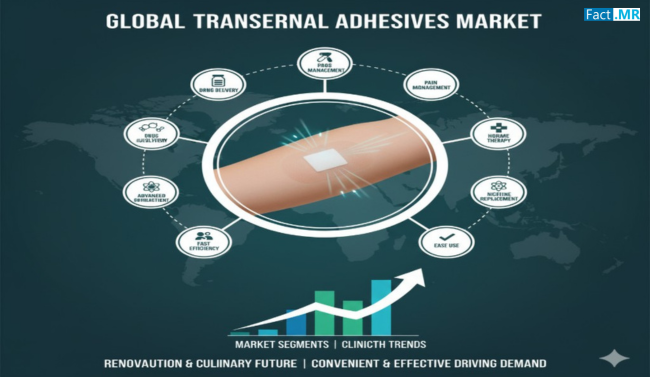The transdermal adhesives market is witnessing significant growth as healthcare providers and pharmaceutical companies increasingly prioritize patient-centric drug delivery solutions. Transdermal adhesives, commonly used in patches, provide a reliable and non-invasive method of delivering medications directly through the skin. This technology has transformed treatment approaches for pain management, hormone replacement therapy, nicotine cessation, and chronic disease management, offering improved patient compliance and convenience.
Market Overview:
Transdermal adhesives are engineered to provide controlled and sustained drug release, allowing for a steady therapeutic effect while minimizing side effects often associated with oral medications or injections. These adhesives are primarily composed of a backing layer, an adhesive layer, and a drug-containing reservoir, crafted from materials such as silicone, acrylic, or rubber-based polymers. The versatility of these adhesives enables their application across multiple therapeutic areas, ensuring safe and efficient drug delivery.
Regional Insights:
North America currently leads the transdermal adhesives market due to advanced healthcare infrastructure, rising prevalence of chronic diseases, and significant pharmaceutical research and development. Europe follows closely, supported by regulatory frameworks that encourage the adoption of innovative medical technologies. The Asia-Pacific region is emerging as a lucrative market, with countries like India and China witnessing increasing demand for transdermal patches driven by growing healthcare awareness, rising disposable incomes, and government initiatives to enhance medical access.
Key Trends & Forecast:
- Growth in Hospice and Palliative Care:The rising need for effective pain management in hospice and palliative care settings is boosting the adoption of transdermal patches. These adhesives provide continuous drug delivery, reducing the need for frequent injections and enhancing patient comfort.
- Increasing Prevalence of Chronic Diseases:Chronic conditions such as diabetes, cardiovascular diseases, and cancer require consistent medication delivery. Transdermal adhesives offer a convenient solution, improving adherence and therapeutic outcomes.
- Integration with Wearable Devices:The growing popularity of wearable health monitoring devices is driving demand for reliable skin adhesives that can maintain sensor contact without discomfort. Transdermal adhesives meet this requirement, further broadening their application scope.
- Focus on Personalized Medicine:Pharmaceutical companies are investing in research to develop customized transdermal delivery systems tailored to individual patient needs, enhancing efficacy and safety.
Applications & End-Use Outlook:
Transdermal adhesives are utilized across various healthcare domains:
- Pain Management:Patches deliver analgesics effectively, providing sustained relief without frequent dosing.
- Hormone Replacement Therapy:Adhesives ensure precise delivery of hormones, improving patient compliance and treatment efficiency.
- Nicotine Replacement Therapy:Patches assist in smoking cessation programs by providing controlled nicotine release.
- Chronic Disease Treatment:Transdermal systems enable continuous medication delivery for conditions requiring steady therapeutic levels, enhancing patient outcomes and quality of life.
Opportunities in Emerging Markets:
Emerging markets offer substantial growth potential for transdermal adhesives due to increasing chronic disease prevalence, expanding healthcare infrastructure, and growing awareness of advanced treatment options. Countries like India are experiencing high adoption rates, driven by government healthcare initiatives and the rising need for convenient drug delivery systems. These markets present opportunities for manufacturers to introduce innovative products, enhance accessibility, and establish strategic partnerships.
Challenges & Market Restraints:
Despite significant growth potential, the transdermal adhesives market faces certain challenges:
- High Production Costs:Developing and manufacturing high-quality transdermal adhesives can be expensive, which may limit affordability and accessibility in some regions.
- Regulatory Hurdles:Approvals for transdermal patches can be complex and time-consuming, delaying product launches.
- Drug Compatibility:Not all medications are suitable for transdermal delivery due to molecular size, solubility, or stability issues, which can limit applications.
- Competition from Alternative Drug Delivery Methods:Oral medications, injections, and inhalers continue to compete with transdermal systems, potentially affecting adoption in specific therapeutic areas.
Country-wise Insights:
The United States remains a key market due to its large aging population, high healthcare expenditure, and advanced pharmaceutical industry. India presents a lucrative market, driven by increasing chronic disease prevalence and favorable government policies supporting healthcare growth. Europe continues to see strong adoption due to regulatory support and increasing focus on innovative medical technologies.
Conclusion:
The transdermal adhesives market is positioned for sustained growth as healthcare providers and pharmaceutical companies prioritize patient-centric, efficient, and non-invasive drug delivery methods. By offering controlled medication release, enhancing patient compliance, and supporting emerging applications such as wearable devices and personalized therapy, transdermal adhesives are reshaping modern healthcare practices. Strategic investments in research, innovation, and regional expansion will further strengthen the market, offering a promising future for both manufacturers and patients alike.



